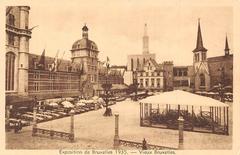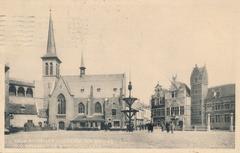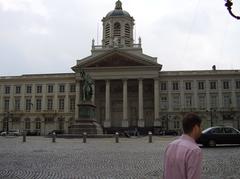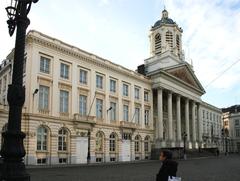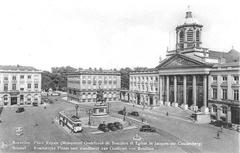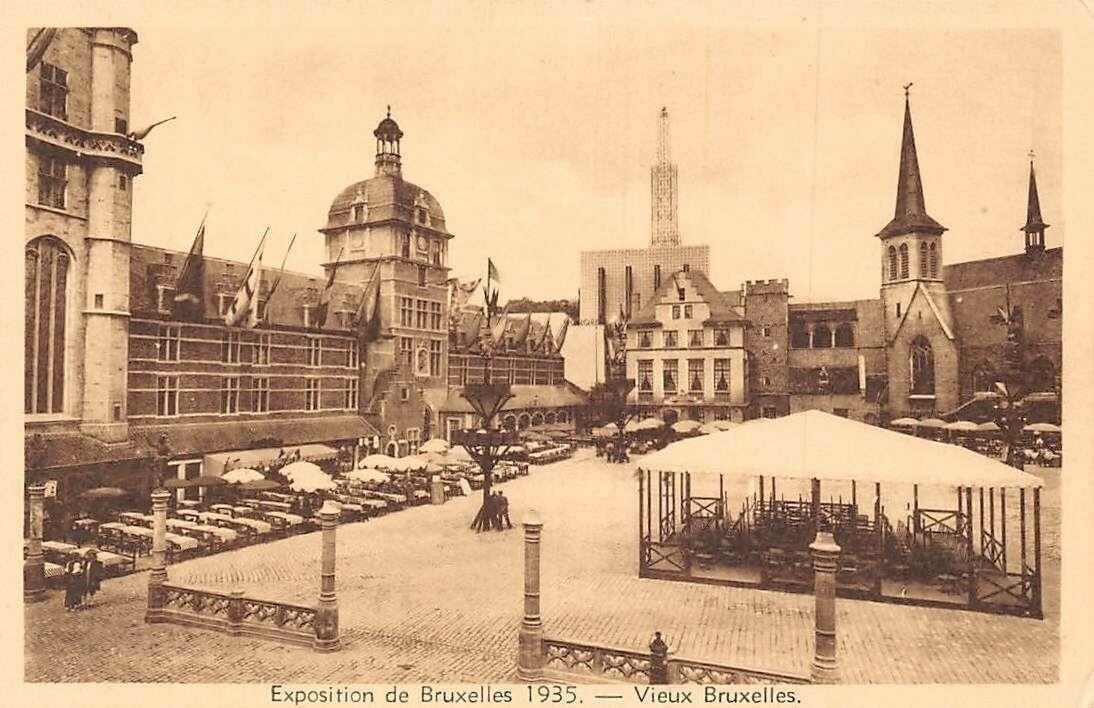
Church of Saint Jacques-sur-Coudenberg Brussels: Visiting Hours, Tickets, and Historical Guide
Date: 14/06/2025
Introduction
The Church of Saint Jacques-sur-Coudenberg (Église Saint-Jacques-sur-Coudenberg; Dutch: Sint-Jacob-op-Koudenbergkerk) is a neoclassical jewel anchoring the historic Place Royale at the heart of Brussels. Erected between 1776 and 1787 atop the former medieval Abbey of Coudenberg, this church is not only an architectural masterpiece but also a living witness to pivotal moments in Belgian history, including the oath-taking of Leopold I, the nation’s first king. Its graceful façade, luminous interior, and rich artistic heritage make it a must-visit site for history lovers, art enthusiasts, and cultural travelers alike (Brussels Museums, Visit Brussels).
This guide provides an in-depth look at the church’s origins, architecture, historical significance, and practical visitor information, ensuring you make the most of your visit to one of Brussels’ most iconic landmarks.
Table of Contents
- Historical Background
- Architectural Highlights
- Cultural and National Significance
- Visiting Information
- Visitor Tips
- Frequently Asked Questions (FAQ)
- Further Resources & References
Historical Background
The site of Saint Jacques-sur-Coudenberg has been a focal point for Brussels’ religious and political life since the 12th century, originally home to the Abbey of Coudenberg. The abbey and the adjacent Coudenberg Palace, residence of the Dukes of Brabant and later Habsburg governors, stood here until a catastrophic fire in 1731 prompted a complete urban redesign. The Place Royale was constructed as a neoclassical square, and the new church was conceived as its spiritual centerpiece, reflecting Enlightenment ideals and the city’s emerging civic identity (Brussels Museums, Visit Brussels).
The church’s national significance was irrevocably sealed on July 21, 1831, when Leopold I swore the constitutional oath on its steps, marking Belgium’s birth as a constitutional monarchy (Belgian Monarchy). Since then, Saint Jacques-sur-Coudenberg has been the site for royal ceremonies, state events, and annual National Day celebrations.
Architectural Highlights
Exterior Features
The church’s grand neoclassical façade was designed by Gilles-Barnabé Guimard and Louis Montoyer, inspired by Greco-Roman temples. Six Corinthian columns support a stately triangular pediment, giving the church its commanding presence on Place Royale. A distinctive dome and lantern, added by Tilman-François Suys in 1849, replaced the original cupola and further elevate the church’s silhouette (Monument de Bruxelles).
A rare exterior fresco by Jean-François Portaels, painted in 1851, adorns the pediment and depicts the Virgin Mary consoling the afflicted—a unique feature in Belgium’s architectural landscape.
Interior Art and Design
Inside, the church is an exemplar of neoclassical clarity and harmony. The nave is bright and open, with white and gold decorative accents enhancing the uplifting atmosphere. The main altar is crowned by Jean-Baptiste Capronnier’s monumental painting “The Crucifixion.” The side chapels feature works by Jean-François Portaels and sculptures by Laurent Delvaux and François-Joseph Janssens.
Other notable features include:
- Stations of the Cross: Neoclassical reliefs by Jean Geefs.
- Royal Pew and Gallery: Reflecting the church’s historic function as a “royal parish,” the pew connects to the palace gardens.
- Organ: Built in 1844 by Pierre Schyven, renowned for its sound and craftsmanship.
- Stained Glass Windows: Depicting scenes from the life of Saint James and other biblical themes.
Cultural and National Significance
Saint Jacques-sur-Coudenberg is dedicated to Saint James the Greater, reflecting Brussels’ historical role on the pilgrimage route to Santiago de Compostela. Beyond its religious function, the church has hosted pivotal national events—including the swearing-in of Belgium’s first king—and continues to be the royal family’s official church and the cathedral of the Military Ordinariate of Belgium (Royal Palace of Brussels).
The church remains a living center of spiritual and civic life, hosting annual Te Deums on Belgian National Day, royal ceremonies, state funerals, and concerts—particularly as part of Brussels’ Festival of Sacred Music (Festival of Sacred Music).
Visiting Information
Opening Hours
- Monday–Saturday: 10:00 AM – 6:00 PM
- Sunday: 12:00 PM – 6:00 PM
Hours may vary during public holidays, religious services, or special events. Always check the official parish website or call +32 2 502 18 25 for the latest updates.
Tickets and Entry
- General Admission: Free
- Guided Tours & Special Events: Some may require tickets. For example, a 40-minute guided visit can be purchased for €10 or included in certain city passes (Explore Brussels).
Accessibility
The church is wheelchair accessible, with ramps at the entrance and accessible restrooms. For specific assistance or group needs, contact the church administration in advance (Parish Website).
Getting There
Address: Impasse de Borgendael 1, 1000 Bruxelles, Belgium
- Metro: Parc/Park (lines 1, 5); Trône/Troon (lines 2, 6)
- Train: Brussels-Central station nearby
- Tram/Bus: Multiple lines serve Place Royale
- Car: Limited parking; public transport recommended
Guided Tours & Events
- Free Guided Tours: First Thursday of each month, 16:00–16:45, led by a specialist; no reservation needed (Parish Website).
- Organ Recitals & Concerts: Regular classical and sacred music performances, especially during the Festival of Sacred Music.
- Self-Guided Tours: Downloadable walking tours available via GPSmyCity.
Nearby Attractions
- Royal Palace of Brussels
- Magritte Museum
- Royal Museums of Fine Arts of Belgium
- BOZAR Centre for Fine Arts
- Mont des Arts: Gardens and panoramic city views
All are within easy walking distance, making the church an ideal starting point for exploring Brussels’ cultural core.
Visitor Tips
- Dress Code: Modest attire is requested (shoulders and knees covered); remove hats inside.
- Photography: Non-flash photography is generally permitted for personal use; restrictions may apply during services.
- Best Time to Visit: Attend a concert or guided tour for a richer experience, especially during the Festival of Sacred Music.
- Duration: Plan 30–45 minutes for a standard visit; longer if attending a tour or event.
Frequently Asked Questions (FAQ)
Q: What are the church’s opening hours?
A: Monday–Saturday, 10:00 AM–6:00 PM; Sunday, 12:00 PM–6:00 PM. Confirm before visiting during holidays or special events.
Q: Is there an entrance fee?
A: General admission is free; some special tours or events require tickets.
Q: Are guided tours available?
A: Yes, both free and paid guided tours are offered; see the parish website for details.
Q: Is the church accessible for people with disabilities?
A: Yes, with ramps and accessible facilities.
Q: Can I take photographs inside?
A: Yes, but avoid flash and respect any restrictions during services.
Q: What are nearby attractions?
A: Royal Palace, Magritte Museum, Fine Arts Museums, BOZAR, Mont des Arts.
Further Resources & References
- Brussels Museums: Church of Saint Jacques-sur-Coudenberg
- Heritage Brussels
- Explore Brussels
- Parish Website
- Royal Palace of Brussels
- Belgian Monarchy: Leopold I
- Festival of Sacred Music
- Wikipedia: Church of St. James on Coudenberg
- Monument de Bruxelles
- GPSmyCity: Saint Jacques-sur-Coudenberg
- IBN Battuta Travel
- Brussels City: Minimes Cantat
- Spotting History
Plan Your Visit
Discover the spiritual, architectural, and historical essence of Brussels at the Church of Saint Jacques-sur-Coudenberg. For up-to-date information, guided tours, and exclusive audio content, download the Audiala app. Enhance your journey by visiting other nearby Brussels historical sites, and follow us on social media for event updates and insider tips.
